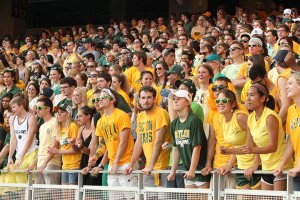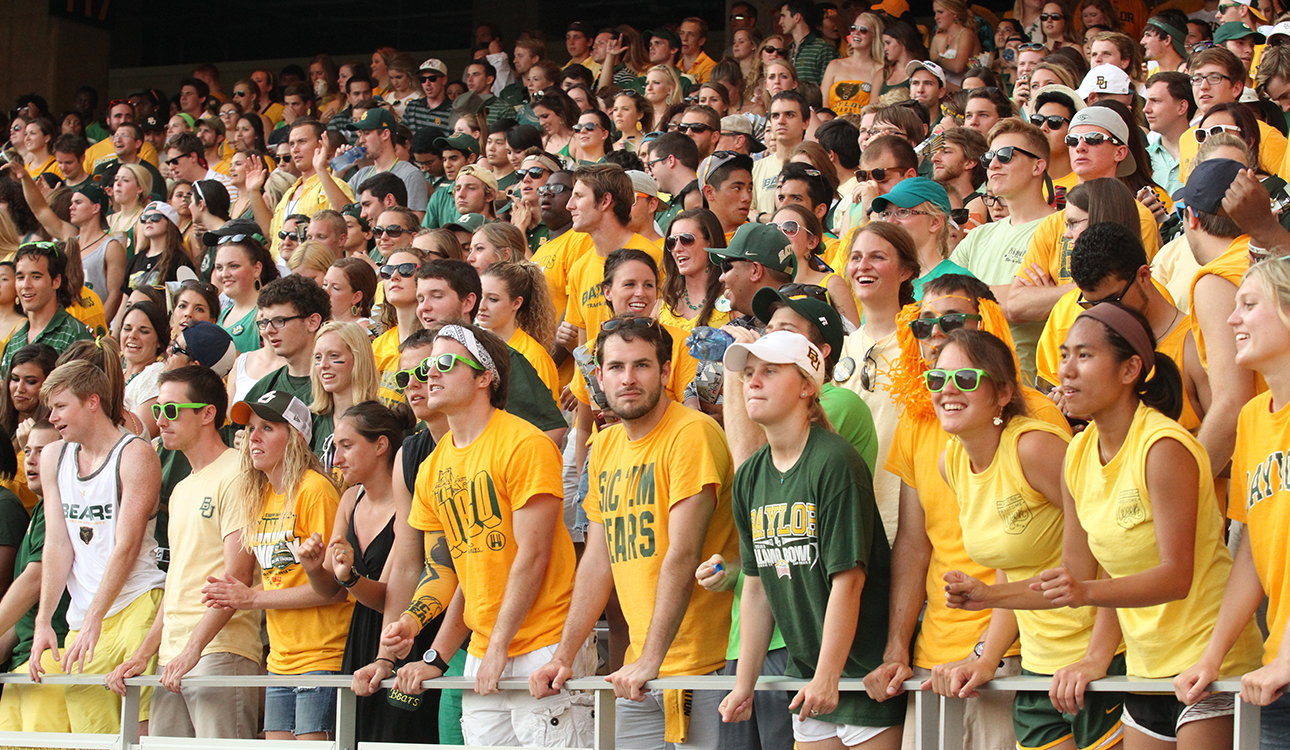
Kevin Freeman | Lariat Photographer
By Shehan Jeyarajah
Sports Editor
Interest in Baylor football is at an all-time high, and student attendance has been an indicator of success.
Over 45,000 people were in attendance for the first Baylor football game at McLane Stadium, which included over 9,000 ticketed students, one of the highest marks ever.
Despite the success for the athletic department, the Department of Student Activities acknowledged the new ticketing system was not yet perfect. However, steps have been taken in an effort to remedy student concern.
Student Attendance
Athletic director Ian McCaw estimated that approximately 6,500 student tickets were distributed on average the past three seasons, which was a significant improvement from previous seasons.
However, between a growing school and rapidly improving football program, Baylor struggled in 2013 to ensure free tickets for the amount of students desiring to attend.
With the opening of McLane Stadium, a venue that boasts 5,000 fewer seats than Floyd Casey Stadium, and a nationally competitive football team, student tickets are now even more scarce.
Baylor has set aside 8,500 student tickets for each home: 5,200 general admission, 2,800 Baylor Line and 500 berm.
In comparison, Baylor gave out over 10,000 tickets to students to attend the Bears’ 41-12 victory over No. 10 Oklahoma on Nov. 7, 2013.
Director of Student Activities Matt Burchett said contrary to popular belief, Baylor did have the means in place to accommodate all students who wanted to attend the game on Sunday.
He said there were over 200 remaining student tickets for the opener against SMU between returns and standing room.
“If you factor in the team, factor in the cheerleaders, factor in students who are working in other area during the game or working in the athletic department or in the band, you’re probably knocking on the door of around 9,500 to 10,000 students out of an undergrad population of 13,000,” associate athletic director Nick Joos said.
Although McLane Stadium has the ability to expand by up to 10,000 seats, Baylor made the decision to cap attendance at 45,000, at least for the first year.
McCaw pointed to declining attendance trends around the country in Baylor’s wait-and-see approach on increasing the size of the stadium.
“We want there to be demand,” McCaw said. “We want Baylor football to be a hot ticket. We don’t want a situation again where we have to put another tarp on this stadium.”
Joos said he agreed with McCaw’s sentiments.
“For the first time, perhaps even in program history, we think we are on the right side of the supply and demand curve,” Joos said. “The other thing you have to factor in is that all of our games are on television now. That’s a good reason for people not to come to games. We decided we would have a smaller and more intimate environment because we want it full every week with Baylor fans.”
Distribution System
Burchett and Kevin Jackson vice president of the Division of Student Life said Baylor is moving towards online ticketing because that is what the office found students wanted.
“For the SMU game, the system sold out in under an hour,” Burchett said. “The system distributed three tickets a second. [On Monday], the system sold out in only 19 minutes, and moved up to giving out six tickets a second. In comparison, some students waited as long as six hours in line for tickets for the Oklahoma and Texas games.”
Burchett said throughout the ticketing process for the SMU game, which took longer than what was hoped, Baylor had between 16 and 18 staff on a conference call to monitor email and social media for feedback and criticism.
“We heard that the waiting list page was confusing, and we changed that in minute 24,” Burchett said. “We were able to resolve small issues with people’s accounts within a minute. For bigger site issues, we got most resolved in three to five minutes.”
Burchett said the system went much smoother the second time through during distribution for Baylor’s game against Northwestern State. The game sold out in almost a third of the time.
Jackson said the return process has been a great success, with hundreds of returned tickets being redirected to students for the SMU game.
“In the past, if a student picked up a ticket and did not go, that was taking away from a student who could have been there,” Jackson said. “This solves that issue.”
Returned tickets will be distributed physically to students at the Bill Daniel Student Union four hours before a given game.
Jackson said he envisioned going to the SUB box office before game time like going to the Broadway ticket office in Times Square; there will not always be tickets available, but it is worth swinging by before to check because you may find a deal.
Burchett said the plan is to eventually move the entire ticketing system online, starting with basketball in the near future.
Joos also revealed the plan is eventually to move from paper to virtual tickets, where students would be able to download and scan the ticket on their phone.
“We probably won’t introduce it this season, but it’s the next step heading forward,” Joos said.
Nick Joos said throughout the process, Baylor athletics’ goal has been to serve the students as well as possible.
“We’ve got to take care of our students,” Joos said. “The way the Baylor Line, was designed, they have really great seats. When I worked at Nebraska, students were in the corner of the end zone; our students have sideline-to-sideline seats at the 100 level, and we really feel like we need them at the games.”






